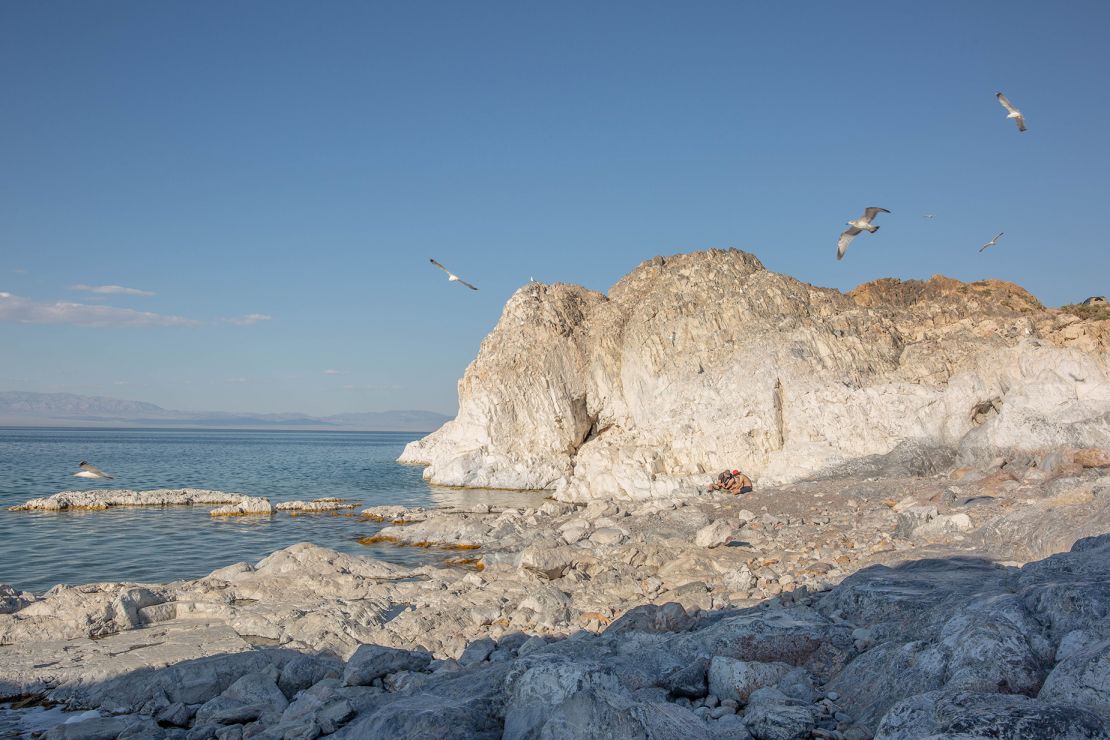Editor’s Note: This CNN Travel series is, or was, sponsored by the country it highlights. CNN retains full editorial control over subject matter, reporting and frequency of the articles and videos within the sponsorship, in compliance with our policy.
Traveling to western Mongolia’s Khyargas Lake from capital Ulaanbaatar isn’t for the faint of heart.
The drive is roughly 1,800 kilometers (about 1,118 miles), which can take anywhere from one to three days to cover, depending on how comfortable you are behind the wheel on this country’s challenging roads.
And then there’s the weather –- it’s not uncommon to experience three seasons in an afternoon when roadripping in Mongolia.
Once you get to the lake, it’s another 43 kilometers over washboard roads, some stretches filled with deep sand, to reach its most famous landmark, Khetsuu Khad.
But the journey is more than worth it – particularly at a time when stories and images of overcrowded destinations and fed-up locals continue to dominate headlines worldwide.
Known for its whitewashed cliffs and crystal-clear waters, this little-known Mongolia site makes visitors feel more like they are in the Mediterranean than a remote corner of Asia.
“Khyargas Lake is one of Mongolia’s best-kept secrets,” says outdoor enthusiast and Ulaanbaatar local Uyanga Vladimir of TIC 4x4 and Outdoor, who shares photos of her travels on Instagram at @uvtravels.
“The uniqueness of its landscape and the rocky formations surrounding the area compared to what you’d normally expect in other regions of the country is fascinating. Khyargas Lake looks and feels more like Greece than anything else. It’s almost other-worldly.”
While joining the handful of locals who come to swim in these magical waters, there’s a feeling you’re witnessing something special. This untouched, raw beauty is part of the lake’s charm and makes the experience even more memorable.
But, according to Vladimir, it isn’t just the scenery that’s other-worldly.
“There’s a legend that says a giant blue bull lives within the depths of Khyargas Lake,” he explains. “And each fall, the bull would rise from the bottom of the lake to visit only but a few herder families and bless them with abundant livestock for the coming year.”
One of Mongolia’s biggest lakes

One of several salt-water lakes in the country, Khyargas is located in the northwest province of Uvs and feeds into the Zavkhan River basin, an area famous for its semi-desert climate. (You’re more likely to see the country’s famous Bactrian camels walking along the lake’s shores than people.)
At 74 kilometers long, 31 kilometers wide and reaching depths of 80 meters, it’s Mongolia’s third-largest lake.
Khetsuu Khad, the main attraction, is a natural rock formation that runs along the eastern shore. If planning to visit on your own, a 4x4 capable SUV that can handle deep sand is highly recommended. (Just ask all the Prius drivers that are seemingly rescued on an hourly basis).
Alternatively, boats travel to Khetsuu Khad from the lake’s north shore, which is a popular beach and camping spot.
There are a few lodges on the lake, including the Khetsuu Khad Tourist Camp and Baruun Beach Resort. Both are located 43 kilometers off the main road to Khyargas. The drive can take upwards of two hours, depending on whether you get bogged down in the dunes.
There is also a free camping area in front of Khetsuu Khad, which is a popular choice for locals.
While there’s no official entrance or designated ranger station, officials do roam around the lake. When making their rounds, they’ll ask you to pay a modest entrance fee of 9,000 tugrik, which is less than $3.
Pockets of hot springs can be found around the lake, while natural springs sit to the north.
Birder’s paradise

For bird enthusiasts, the shores of Khyargas Lake, especially Khetsuu Khad, are a huge draw.
Several globally threatened species can be found here. An early morning spotting session can include Dalmatian pelicans, bar-headed geese, great crested grebes, great cormorants, cinereous vultures, little owls, Eurasian kestrels, lesser whitethroats, Siberian stonechats, isabelline and desert wheatears and house and rock sparrows.
Migratory birds arrive at the lake in April and are off again by mid-September. Most notably, travelers come to see the big, round great cormorant nests that sit atop the cliffs of Khetsuu Khad, where they lay and hatch their eggs.
There is also an abundance of fish species such as the Mongolian grayling, Altai leuciscinae, lake osman and dace – all a great food source for the birds.
The antidote to overtourism?
As noted earlier, getting to Khyargas Lake from Ulaanbaatar is a long drive. Eager travelers could reach it within a day. Taking 2/3 days to cross the 1,800 kilometers is more realistic.
Otherwise, travelers can fly from Ulaanbatar to Ulaangom, the capital of Uvs province, which sits just 220 kilometers away from the lake. Several tour operators offer journeys in the region that include visits to the lake as well.
Meanwhile Uvs, in the northwest near the Russian border, is Mongolia’s largest province and also one of its most diverse. There aren’t just picturesque lakes here; snow-capped mountains and arid deserts also make up this unique part of the country.
When immersed in the rugged rawness of this remote corner of Mongolia, one can’t help but contrast the experience with the overcrowded destinations many visited this summer, a season filled with news of Spanish towns fining tourists for hogging beach spots and spraying water guns at tourists in the streets, and Japanese officials being forced to take action against an overload of Mount Fuji visitors, to name just a few incidents.
It’s a nice reminder that Mongolia’s lesser-known natural wonders, while by no means easy to reach, are great alternatives to some of the famed global destinations that are becoming increasingly challenging to enjoy.
Follow Breanna’s Mongolia adventures on Instagram at @breannajwilson





